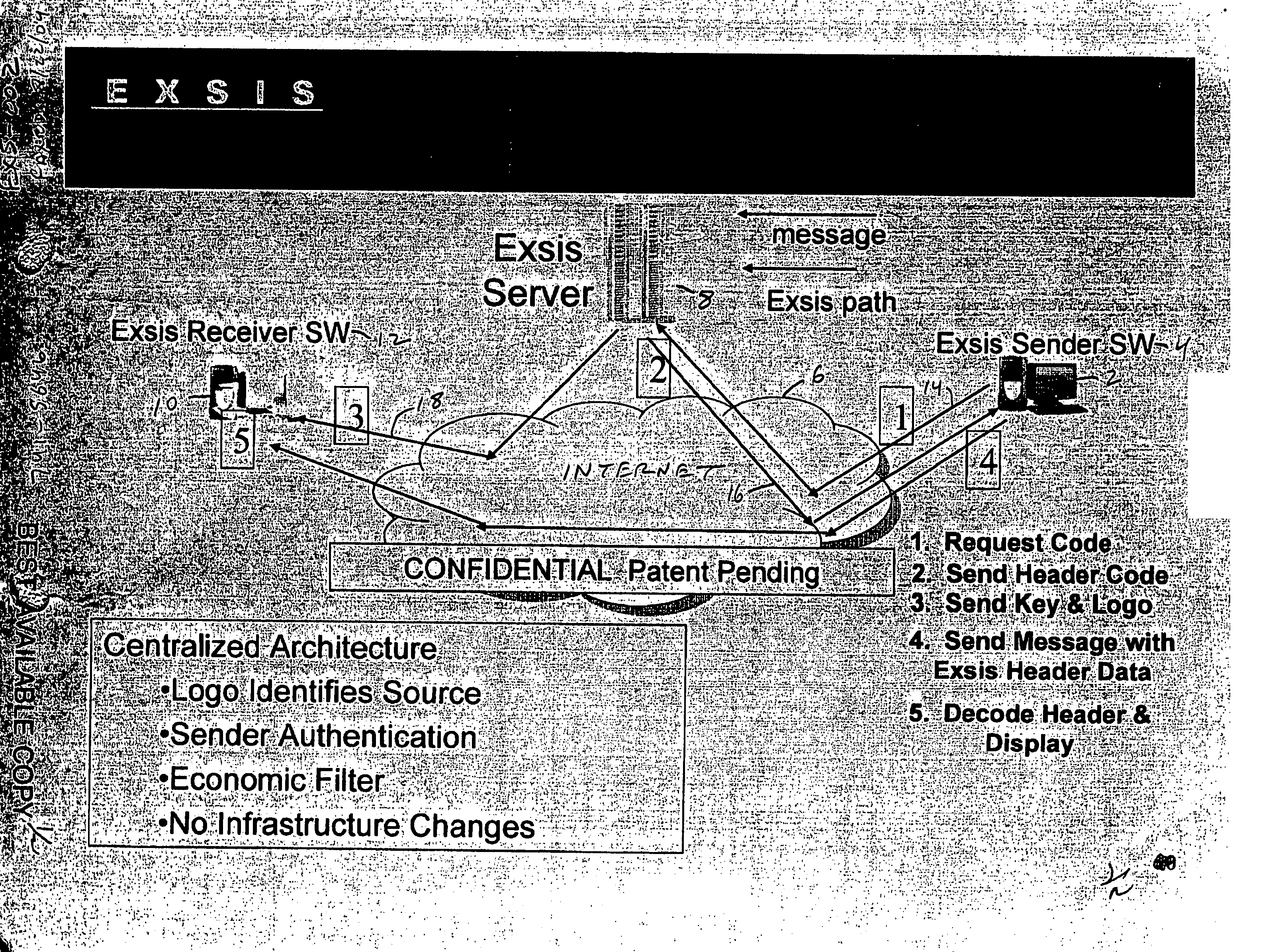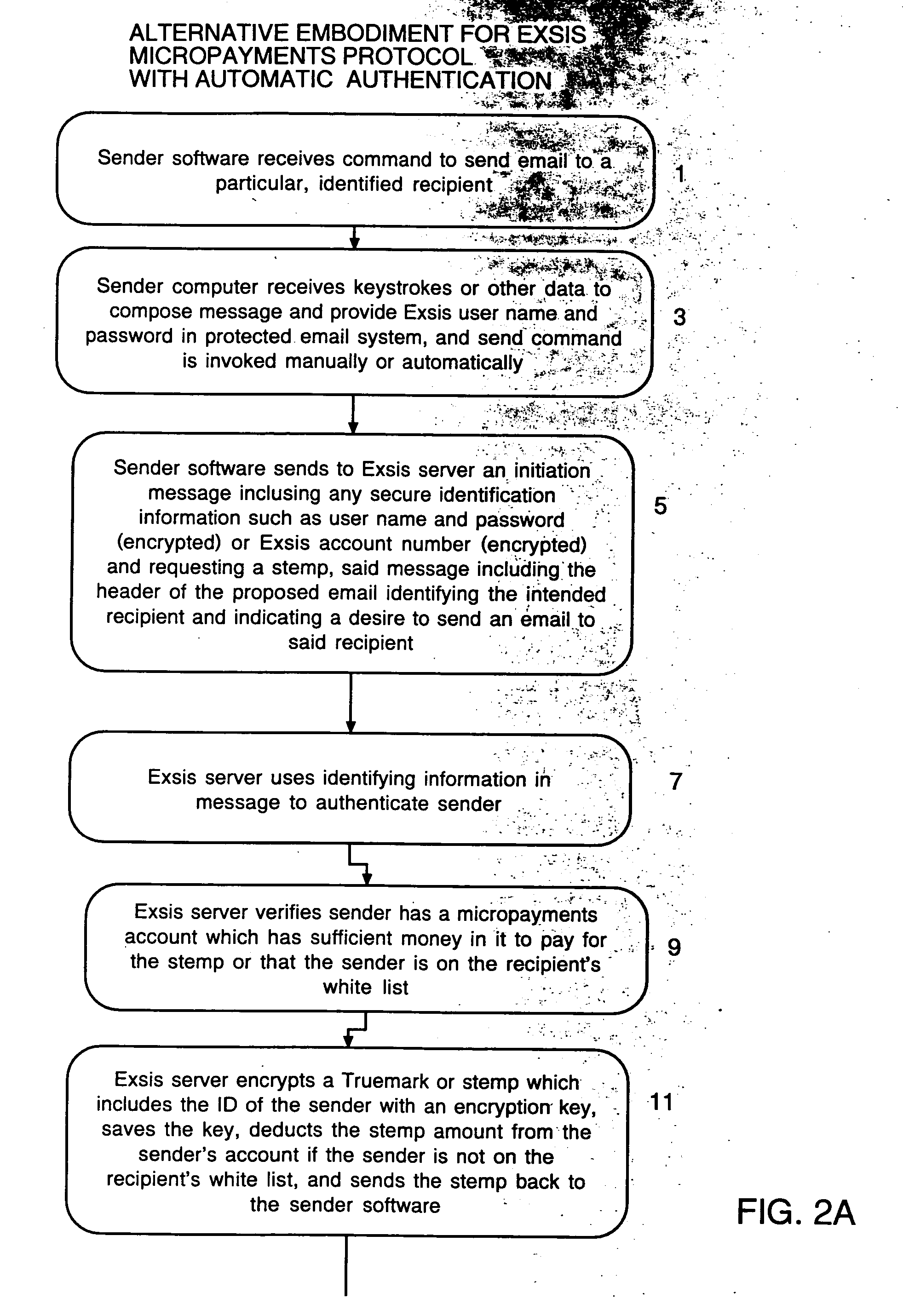User interface and anti-phishing functions for an anti-spam micropayments system
a micropayments system and user interface technology, applied in the field of user interface and anti-phishing functions of an anti-spam micropayments system, can solve the problems of large amount of unsolicited emails, so as to control the contents of the exsis inbox more effectively
Active Publication Date: 2006-04-06
ICONIX INC
View PDF6 Cites 207 Cited by
- Summary
- Abstract
- Description
- Claims
- Application Information
AI Technical Summary
Benefits of technology
[0040] The opt out ability of the system allows a user to control his Exsis inbox contents more effectively than in the prior art. It is very common for companies from whom products were purchased to request email addresses on their product registration cards. They then use this information to send additional messages the user may not want or sell the email addresses to others who then send further unsolicited emails. Thus, the opt out function allows recipients to block receiving emails
Problems solved by technology
Unsolicited email is becoming a large problem on the internet.
However, bulk emailing of unsolicited emails is not the only problem the internet suffers from.
Phishing has become a large problem in email communications over the internet.
If the user supplies the information, an identity theft often follows.
Phishers have been achieving as high as about 5% click through rate on these type ploys and have been stealing a large amount of sensitive information.
Naturally this ability to cause a user's browser to display a page which looks like it is being offered by a legitimate business can and currently is leading to abusive practices which micropayment systems cannot stop.
Technical means cannot detect these perfectly legitimate URLs.
Further, since the Microsoft/Yahoo Sender ID scheme only checks for the authenticity of the top level domain, and all these imposters have legitimate top level domains, this prior art authentication scheme will not work to protect a recipient of an email
Method used
the structure of the environmentally friendly knitted fabric provided by the present invention; figure 2 Flow chart of the yarn wrapping machine for environmentally friendly knitted fabrics and storage devices; image 3 Is the parameter map of the yarn covering machine
View moreImage
Smart Image Click on the blue labels to locate them in the text.
Smart ImageViewing Examples
Examples
Experimental program
Comparison scheme
Effect test
 Login to View More
Login to View More PUM
 Login to View More
Login to View More Abstract
A protocol for protected email transmission using micropayments and a segregated inbox in which protected emails are displayed. The protocol also involves authentication of the sender to defeat phishers and an opt out protocol which can be used to block protected emails from sources from which the user no longer wishes to receive emails even if the source has made a micropayment. Branded email is also taught wherein a sender of protected emails can pay extra to have a miniature version of its brand logo or trademark displayed with its email in the segregated inbox. A white list is maintained on the protected email server (along with the opt out black list) so that recipients can designate specific senders who may send email to that recipient without paying a micropayment and still have the protected email displayed in the segregated inbox.
Description
BACKGROUND OF THE INVENTION [0001] Unsolicited email is becoming a large problem on the internet. One solution to this problem is the use of a micropayments system where emails from sources not on a recipient's white list do not get to recipients unless the sender has taken steps to make a small payment called a micropayment. Emails for which micropayments have been made include in them coding which is called a stemp and which indicates the micropayment has been made. One such micropayments system is disclosed in U.S. patent application METHOD AND APPARATUS FOR IMPLEMENTING A MICROPAYMENT SYSTEM TO CONTROL E-MAIL SPAM, filed Feb. 12, 2004, Ser. No. 10 / 778,956 as assigned to the assignee of the present invention. [0002] While that patent application describes the details of how a micropayments server cooperates with client computer executing sending and receiving processes, it did not go into a user interface for interacting with users regarding the presence or absence of stemps on i...
Claims
the structure of the environmentally friendly knitted fabric provided by the present invention; figure 2 Flow chart of the yarn wrapping machine for environmentally friendly knitted fabrics and storage devices; image 3 Is the parameter map of the yarn covering machine
Login to View More Application Information
Patent Timeline
 Login to View More
Login to View More IPC IPC(8): G06F15/16
CPCG06Q10/107H04L12/585H04L12/66H04L51/12H04L63/0428H04L63/126H04L51/212
Inventor ZAGER, ROBERT PHILIPAMES, WILLIAMPICAZO, JOSE JESUS JR.VEMPATY, NAGESHWARA RAODUVVOORI, VIKRAMTRYTTEN, CHRIS DAVID
Owner ICONIX INC
Features
- R&D
- Intellectual Property
- Life Sciences
- Materials
- Tech Scout
Why Patsnap Eureka
- Unparalleled Data Quality
- Higher Quality Content
- 60% Fewer Hallucinations
Social media
Patsnap Eureka Blog
Learn More Browse by: Latest US Patents, China's latest patents, Technical Efficacy Thesaurus, Application Domain, Technology Topic, Popular Technical Reports.
© 2025 PatSnap. All rights reserved.Legal|Privacy policy|Modern Slavery Act Transparency Statement|Sitemap|About US| Contact US: help@patsnap.com



